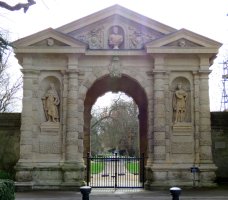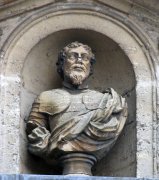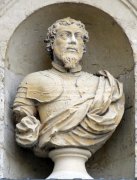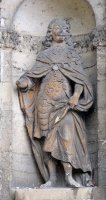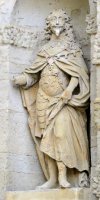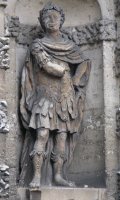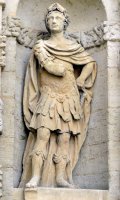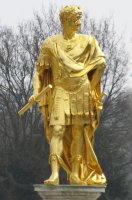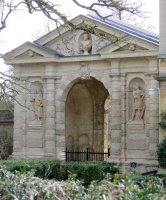Physick Garden Danby Gate, Oxford
A 17th Century Baroque gateway by Nicholas Stone the Elder, with later 17th Century statues of King Charles I and King Charles II, likely by the sculptor John Vanderstein. Stone was the foremost mason and sculptor of his time, and the statues are interesting examples of surviving work of their period.
The principal entrance to the Physick Garden, Oxford's ancient botanical garden, is a splendid 17th Century stone gate by Nicholas Stone the Elder, put up in the early 1630s for Henry Danvers, first Earl of Danby, who funded the garden. It is tripartite, the central arched entrance with flanking niches, each with an attached pillar on each side, and a pediment above, so the whole has the look of a Roman triumphal arch. As a 17th Century piece, the Classical architecture is Baroque rather than austere, with much by way of embellishments. The pillars, and the central arch, feature blocking, thus alternate sticking out and recessed segments, with the projecting ones being carved, or rusticated, with wormy lines, fittingly known as vermiculation. The sides have their own small projecting pediments in front of the main one which stretches across and behind. There are carved shields of arms in the smaller pediments, as the keystone, and a further pair above with light foliage carved in relief. Our main sculptural adornments however are the pair of statues of Charles I and Charles II in the niches, and the bust of Danby above in the main pediment, also in a recess.
The statues and bust date from rather later than the gate itself. Apparently, according to Wikipedia, there were originally statues of Charles I and another person, perhaps his Queen. We know there was a restoration by the sculptor William Bird of Oxford (1624-c.1691), whose most familiar works are the heads of emperors etc around the Sheldonian Theatre: he is recorded as 'mending the King's and Founder's Arms over the Gate in 1660-61. Then around 1690 came the statues and bust we see today, for payments are noted to 'Vanderstene, carver' in 1694-5, of 26 pounds and 10 shillings, and then in the following year to 'John Vandersteen, carver, for cutting the Earl of Danby's statue and for other work', 7 pounds and 12 shillings. These two entries in the Vice-Chancellor's Accounts are the basis of the attribution of the statues, and the bust of Danby above, with Vanderstein (as we generally spell his name today) known to have carved a series of eight statues for Queens College Library nearby, including a Charles I rather similar to the statue of him here.
Henry Danvers, benefactor to the Physick Garden. The bust, which is securely due to Vanderstein, though much repaired and recut around the face, shows the founder bareheaded, bearded, wearing plate armour covered partly by a generous cloak. The visible arm is broken off quite crudely, and the base of the bust, at a bit above navel level, is rather broken, and on a modern base.
Charles I, before and after restoration.
We cannot be entirely sure of the attribution of the statues of Charles I and Charles II – it is a little odd that the accounts do not say that the earlier payment was for statues of the two kings, and other mason-sculptors were involved with the Garden; notably, the master mason Thomas Robinson of Oxford had been paid 122 pounds and 8 shillings and 11 pence for unspecified work the year before; William Bird has also been suggested, which would date the statues rather earlier, to his work in the Garden of the 1750s. On the whole, the Vanderstein attribution seems the most likely.
Not that the statues are hugely original in design. The Charles I is closely modelled on portraits of him, with broken goatee beard and whiskers, and long hair, more forward on his left shoulder (to our right as we look at it), just as in the busts of him in Whitehall and in Portsmouth - though some of this is because of a recent repair and restoration of both statues, giving a slightly less rounded face and replacing the broken beard. His robe sweeps over his left arm, held up in his hand; his right arm is broken off below the elbow; the pose is somewhat flamboyant, as was the style of the time. The Charles II statue, with damaged face and missing hand, has him attired as a Roman emperor, with short tunic above boots leaving the toes bare, cloak, and a crown of leaves. The piece is closely modelled on the more noble figure of Charles II by Grinling Gibbons, outside Chelsea Hospital, for whom Vanderstein had worked for in his younger days. The bust, which is securely due to Vanderstein, though much repaired and recut around the face, shows the founder bareheaded, bearded, wearing plate armour covered partly by a generous cloak. The visible arm is broken off quite crudely, and the base of the bust, at a bit above navel level, is rather broken, and on a modern base.
Charles II, and Grinling Gibbons earlier statue.
A few words on John Vanderstein [Vanderstaine, Van Der Stene, etc]. He worked, as noted for Grinling Gibbons in London, and was employed at Windsor Castle on the Royal Throne in 1678-79, going to Oxford by 1784/5, with his work in the Physick Garden and for Queen's College in the 1890s. In his time in London, his assistants were recorded as John van Nost and Arnold Quellin, who both became rather more significant sculptors than Vanderstein.
Nicholas Stone the Elder, the original mason of the Danby Gate, and other entrances to the Physick Garden, was the leading mason and sculptor of that time, producing as well as architectural work, many monumental sculptures. In Oxford, just up the street from the Danby Gate, is another architectural piece by him, the ornate entrance porch to St Mary's Church.
Also noted on these pages in Oxford: Martyrs Memorial
